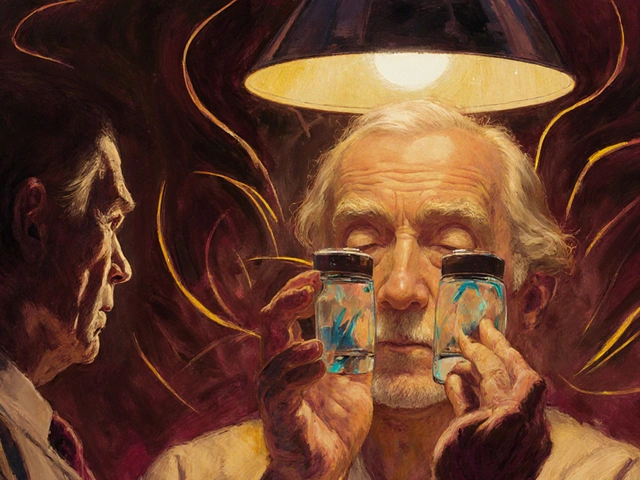If you’ve ever wondered what’s really hiding behind the name “Proscar,” brace yourself. This little pill, which first hit pharmacy shelves in the early 1990s, has quietly shaped the lives of millions of men worldwide. Far from being just another prescription in a sea of confusing medicine names, Proscar is at the heart of men’s health routines—transforming awkward conversations into personal breakthroughs. Its story weaves through doctor’s offices, tablet trays, and even the world of cosmetic hair treatments. Yet, for all its fame, most people can’t tell you what it actually does without a quick search. Let’s flip the packaging and dive into the honest truth about Proscar—without tiptoeing around.
What is Proscar and How Does it Work?
Proscar is the brand name for finasteride, a drug first approved by the U.S. FDA in 1992. What sets Proscar apart is how it targets a specific enzyme in the body called 5-alpha reductase. This enzyme is responsible for converting testosterone into dihydrotestosterone (DHT), a more potent hormone that plays a key role in prostate growth and male pattern baldness.
So, why block DHT? In men with benign prostatic hyperplasia (BPH), more commonly known as an enlarged prostate, higher levels of DHT can cause the prostate to grow uncomfortably large. This leads to all kinds of urinary annoyances: difficulty starting urination, weak stream, or the nagging feeling you didn’t really finish peeing. By lowering DHT levels with Proscar, prostate size shrinks over months, symptoms get milder, and bladder function often improves. It’s not instant—think of it as a gradual unwinding of something that’s taken years to develop.
In everyday use, Proscar (5 mg dose) is officially prescribed for BPH, while finasteride at a lower dose (1 mg) under the brand name Propecia is used for male pattern hair loss. That’s where things get interesting: the same active ingredient, with two very different missions. But, please, don’t go splitting or repurposing pills yourself. The difference in doses matters, and so do the conversations you should have with your doctor.
Another fascinating point: Proscar won’t cure prostate cancer, but several large studies have looked at whether it might prevent it. In fact, the 2003 Prostate Cancer Prevention Trial found that finasteride reduced the overall risk of developing prostate cancer by about 25%. But, and this is a big but, some higher-grade tumors seemed to crop up more often. The FDA took note and did not approve Proscar for prevention—though the story sparked a lot of debate among experts.
If you’re curious how Proscar stacks up against other BPH treatments, here’s a quick cheat sheet in table form:
| Drug Name | How It Works | Typical Use | Key Side Effects |
|---|---|---|---|
| Proscar (Finasteride) | Inhibits DHT production | BPH, hair loss (lower dose) | Sexual side effects, less often rash |
| Tamsulosin (Flomax) | Relaxes prostate/bladder muscles | BPH | Dizziness, ejaculation changes |
| Dutasteride (Avodart) | Similar enzyme blocker; stronger | BPH | Similar to finasteride, more potent DHT block |
Benefits, Results, and What to Expect
The talk about Proscar wouldn’t be complete without diving into the benefits users actually see. Most men start Proscar not expecting fireworks but hoping for relief. The majority will notice a change around the three to six-month mark. That's right—patience is required. Suddenly, you may find you're making fewer bathroom trips at night (no more midnight dance to the toilet). That burning or weak flow? For many, it eases up, letting you focus on your day instead of your water intake.
Doctors often judge success by improvements on the American Urological Association Symptom Index (AUA-SI) score. In clinical trials, Proscar consistently showed a 30-40% reduction in BPH symptoms versus placebo. Statistically, urinary flow rates (measured in mL/sec by urologists—yes, they measure this stuff) improve by about 2 mL/sec after six months, which is significant when you’re struggling. Even prostate size, checked by ultrasound, tends to shrink by about 20% on average.
On the prevention side, Proscar lowers the risk of acute urinary retention—those panic moments when you suddenly can’t go at all. Several large studies, including data published in The New England Journal of Medicine, showed about a 57% risk reduction after four years of steady use. And, when it comes to avoiding prostate surgery, which can be invasive and stressful, men using Proscar are about half as likely to need it compared to those on placebo.
The data has impressed specialists, but it's the daily stories that matter too. I’ve heard men say they finally enjoyed a movie without a restroom break, got better sleep, or finally stopped embarrassing sprint sessions in the office. It’s not exaggerated marketing—it’s just the slow, boring magic of a drug that works quietly in the background.
Now, about that hair. While Proscar’s higher dose isn’t meant for hair loss, the finasteride family (as Propecia) has turned into a billion-dollar business for young men clinging to their locks. In that crowd, the benefit is a stop (or at least a slowdown) to hair thinning. Studies back up a noticeably thicker mane for many who stick with it, but again, expect slow-motion changes, nothing overnight.
Some practical tips? Stick to your doctor's dose, take it the same time every day, and don't get discouraged at the three-month “is this working?” phase. Also, remember that missing a dose here or there isn’t the end of the world—just pick up where you left off. Long-term use seems to give the best results, but your doctor should review things annually to make sure it’s still needed.

Side Effects, Risks, and What to Watch Out For
No medication is ever without its sticky bits, and Proscar is no exception. The side that gets most attention—and probably makes some men shudder before therapy—is sexual side effects. In large trials, about 3 to 5 percent of men experienced decreased libido, difficulty getting or maintaining an erection, or a drop in semen volume. For most, these are mild and fade as the body adjusts; for others, they hang around and then disappear when the drug is stopped.
Every so often you’ll see headlines about “post-finasteride syndrome.” That’s the name for a rare but controversial group of symptoms (like ongoing sexual dysfunction, depression, or brain fog) that some men claim persists even after stopping the drug. The FDA recognizes sexual side effects but doesn’t formally acknowledge this syndrome because data is mixed, but it’s wise to be open in your conversations with your doctor, especially if anything feels off.
Gynecomastia, or breast tissue growth/tenderness, is another side effect. It’s rare (under 1% of users), but men should watch for any unusual lumps or tenderness and flag this with their healthcare provider. Allergic reactions happen, as with any drug, but they’re extremely uncommon.
A few things you probably haven’t heard: Proscar can lower prostate-specific antigen (PSA) levels, a key marker in prostate cancer screening. So, if you’re getting your PSA checked, make sure your doctor knows you’re on finasteride—the test result will read about 50% lower. This matters for accurate readings and future monitoring.
Let’s talk numbers for a moment. Here’s a quick rundown, comparing common Proscar side effects seen in clinical trials:
| Side Effect | Proscar (%) | Placebo (%) |
|---|---|---|
| Low libido | 3.8 | 2.1 |
| Erectile issues | 3.7 | 2.1 |
| Breast tenderness | 0.5 | 0.1 |
| Rash | 0.5 | 0.4 |
The good news? Serious reactions are rare. And honestly, the stories where a guy sticks with the drug, weighs the pros and cons, and ends up happy outnumber those who quit for side effects. Just be honest with your healthcare team, keep tabs on new symptoms, and be aware of the signs. If something feels off, don’t brush it aside.
Smart Tips for Safe Use and Common Questions
If you’re eyeing a Proscar prescription (or already have bottles stacked in your drawer), a few practical strategies can make life easier. First, always tell every health provider you see that you’re on finasteride—it can mess with your PSA test, as mentioned above. Don’t skip annual check-ups, because your doctor needs to monitor both progress and side effects.
If you live with a partner who is pregnant or might become pregnant, handle tablets with care. The drug can be absorbed through skin, and exposure can harm a developing fetus (specifically, it can affect the development of male genitalia). Tablets should be swallowed whole and never crushed or broken—makes for an easy dinner table rule.
How long does Proscar take to really work? Most men start noticing improvement at the three-to-six-month mark. If there’s zero change at one year, it's time for a frank talk about other options. Stopping suddenly isn’t dangerous, and since there’s no risk of withdrawal, it’s fine to stop if needed—symptoms may gradually return to baseline, though.
- Take your dose at the same time every day. Consistency really helps.
- Store at room temperature, dry spot preferred—no need for the fridge.
- Set a discreet reminder if you’re forgetful (apps work great).
- Alert your doctor to allergies or new health issues—never assume it’s unrelated.
- Ask your doctor if you’re planning surgery or changing other meds, because Proscar can interact (though rarely).
If you’re considering Proscar for hair loss, it’s officially not the same product as the BPH drug—though docs often prescribe low-dose finasteride off-label. Proscar is never for use in women or children. And remember, buying online from sketchy overseas pharmacies is risky—counterfeits do exist, and you want the real stuff.
What does the future hold? Researchers are still exploring if variations in the 5-alpha reductase enzyme might explain why some folks get better effects (or side effects) than others. Personalized medicine may arrive soon, but for now, the classic approach holds strong: a steady pill, patient persistence, and honest conversations.
If you have concerns about price, talk to your pharmacist. Generic finasteride is widely available in most countries and tends to be much cheaper than the branded version. Insurance usually covers BPH treatment but often not hair loss—something to keep in mind.
Proscar may not have billboard ads or influencer hype, but it’s quietly helped millions face the bathroom, the boardroom, or the barbershop mirror with a little more confidence. The important thing is education, dialogue, and thoughtful decision-making. No need to whisper about it anymore—real information beats rumor every time.






Mike Rothschild
Proscar isn't magic but it's one of the few drugs that actually delivers on its promise if you give it time. I've seen guys go from constant midnight runs to sleeping through the night. No hype, just results.
Ron Prince
why do americans take pills for everything i mean sure prostate stuff is real but back in my day we just held it in and drank more coffee
Sarah McCabe
finally someone talks about this without making it sound like a pharmaceutical ad 😌 i’ve been on it for 8 months and honestly my sleep improved more than my hair (which is fine tbh) 🙏
King Splinter
look i get that this stuff works for some people but you ever think maybe the real problem is that we live in a society that makes men feel like they have to be perfect at 40 so they start popping pills to fix what’s basically just aging and stress and also maybe stop drinking so much soda
Michael Friend
they left out the part where 1 in 5 guys end up with permanent sexual dysfunction and then the FDA just shrugs and says ‘well it was only 3%’
Jerrod Davis
It is incumbent upon the patient to recognize that pharmacological intervention for benign prostatic hyperplasia constitutes a significant medical decision requiring comprehensive risk-benefit analysis under the supervision of a qualified urologist.
Dominic Fuchs
so you're telling me the same chemical that makes men go bald less bald also makes their prostates smaller? nature is weird
Asbury (Ash) Taylor
If you're considering this medication, I encourage you to approach it with patience and awareness. Many men experience meaningful improvement, but it's essential to maintain open communication with your provider and monitor your progress over time.
Kenneth Lewis
took proscar for 6 months my sex drive dropped like a rock and my hair still looks like a bird nest 🤡 maybe it wasnt worth it
Jim Daly
proscar is just a fancy word for a pill that makes you feel like you lost your manhood and still cant pee right
Tionne Myles-Smith
you’re not alone if this feels weird to talk about - but honestly? my husband started taking it and now we both sleep better and he doesn’t rush to the bathroom every 20 minutes. it’s not glamorous but it’s life changing
Leigh Guerra-Paz
I just want to say - if you're thinking about starting this, please don't give up after three months. I was skeptical too - I thought it was just another scam - but at six months, I could finally sit through a movie without planning an escape route. It's slow, but it's real. And yes, you deserve to feel comfortable in your own body.
Jordyn Holland
Oh great, another ‘quietly helped millions’ pharmaceutical fairy tale. Next you’ll tell me we should all be grateful for corporate medicine quietly eroding our natural biology while charging $150 for a 30-day supply. How noble.
Jasper Arboladura
The 5-alpha reductase enzyme has two isoforms - type 1 and type 2. Finasteride selectively inhibits type 2, which is predominant in the prostate and scalp. Dutasteride inhibits both. This distinction is critical for understanding differential side effect profiles, yet is rarely discussed in lay media.
Joanne Beriña
why is this even legal? they’re just making men dependent on pills so big pharma can keep raking in cash. America is sick
ABHISHEK NAHARIA
In India we have generic finasteride for less than 10 rupees per tablet. Why do Americans pay 100 times more? Capitalism is a disease
Mike Rothschild
the post mentioned PSA levels drop by 50% - that’s huge. if you’re getting screened make sure your doc knows you’re on it or you could get false negatives